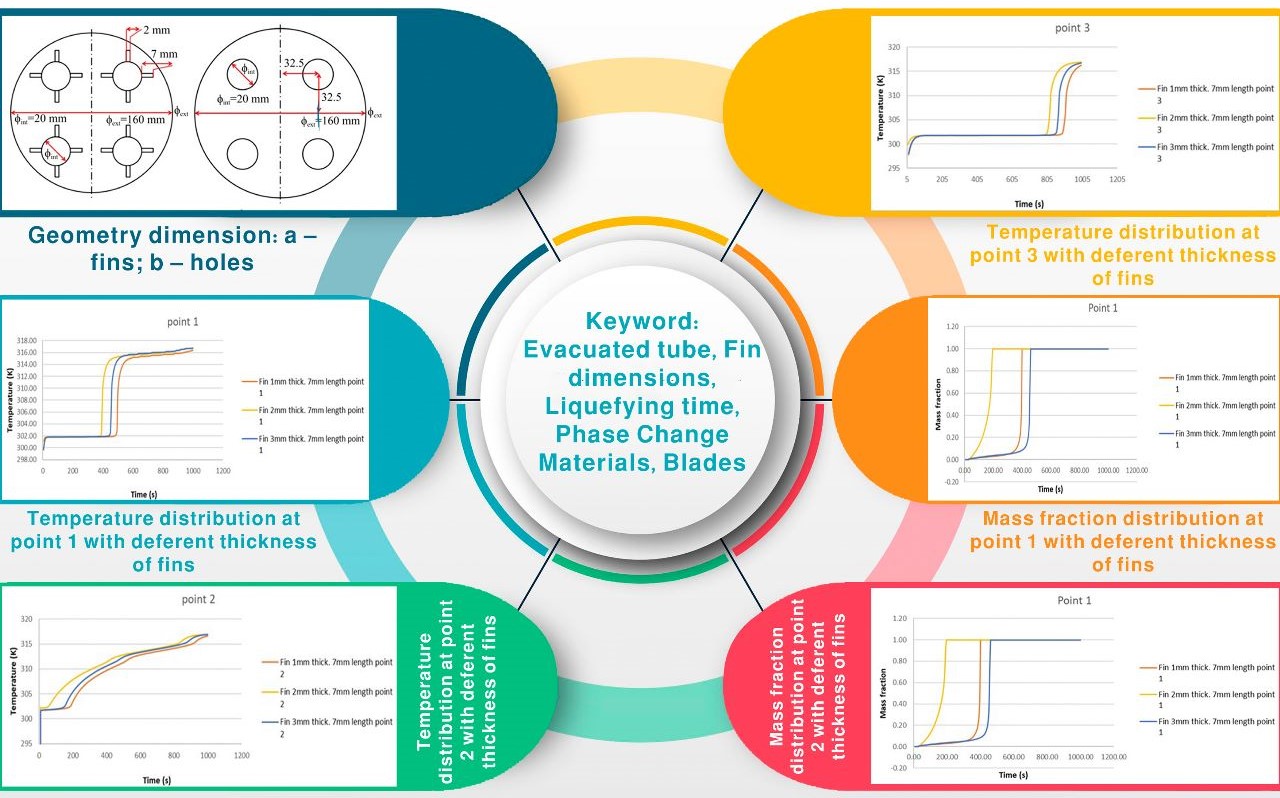Numerical analysis on temperature distribution and mass fraction of an evacuated tube using phase-changing
DOI:
https://doi.org/10.15587/1729-4061.2022.268288Keywords:
Evacuated tube, Fin dimensions, Liquefying time, Phase Change Materials, BladesAbstract
With the advancement of environmentally friendly power innovations and the utilization of phase changing materials in the upkeep of nuclear power, it was important to attempt to further develop the intensity move of stage evolving materials.
A 2D CFD recreation was performed to mimic the softening system of a phase Change material (PCM) which fills a round and hollow pit that incorporates warming sources. CFD model in light of the actual enthalpy equation was utilized to reenact the phase change of strong gallium and for the mathematical timing of the warming sources as per the working circumstances regarding the applied temperatures. Mathematical impact of warming sources, as well as limit conditions for heat move the attributes be analyzed exhaustively.
The Arrangement with balances upgrades heat move and further develops PCM liquefying time. The theory of heat spread in a fin is based on the fact that temperatures rise and fall with the length of the fin. Temperatures reach 316 K at a time of 300 seconds, which is 100 seconds less than when the fin is 7 mm shorter.
The best case for a fin length of 14 mm is the best case compared to the others.
Where has been utilized Fourfold warm blades encompass the intensity pipe in two lengths: 14 mm and 7 mm, with various thicknesses 1, 2, 3 mm and the estimation are mathematically assessed for a few explicit focuses situated inside the concentrated-on developments decide the impact of overhauling warming sources.
As a matter of fact, temperature development and fluid part work on highlights of the concentrated-on developments, which are round and hollow warming sources and finned warming hotspots for the applied temperature (Th=40 °C) the applied temperature
References
- Bouhal, T., ed-Dîn Fertahi, S., Kousksou, T., Jamil, A. (2018). CFD thermal energy storage enhancement of PCM filling a cylindrical cavity equipped with submerged heating sources. Journal of Energy Storage, 18, 360–370. doi: https://doi.org/10.1016/j.est.2018.05.015
- Olfian, H., Ajarostaghi, S. S. M., Farhadi, M., Ramiar, A. (2021). Melting and solidification processes of phase change material in evacuated tube solar collector with U-shaped spirally corrugated tube. Applied Thermal Engineering, 182, 116149. doi: https://doi.org/10.1016/j.applthermaleng.2020.116149
- Kabeel, A. E., Abdelgaied, M. (2018). Solar energy assisted desiccant air conditioning system with PCM as a thermal storage medium. Renewable Energy, 122, 632–642. doi: https://doi.org/10.1016/j.renene.2018.02.020
- Sansaniwal, S. K., Sharma, V., Mathur, J. (2018). Energy and exergy analyses of various typical solar energy applications: A comprehensive review. Renewable and Sustainable Energy Reviews, 82, 1576–1601. doi: https://doi.org/10.1016/j.rser.2017.07.003
- Xu, F., Bian, Z. F., Ge, T. S., Dai, Y. J., Wang, C. H., Kawi, S. (2019). Analysis on solar energy powered cooling system based on desiccant coated heat exchanger using metal-organic framework. Energy, 177, 211–221. doi: https://doi.org/10.1016/j.energy.2019.04.090
- Solano–Olivares, K., Romero, R. J., Santoyo, E., Herrera, I., Galindo–Luna, Y. R., Rodríguez–Martínez, A. et al. (2019). Life cycle assessment of a solar absorption air-conditioning system. Journal of Cleaner Production, 240, 118206. doi: https://doi.org/10.1016/j.jclepro.2019.118206
- Novaes Pires Leite, G. de, Weschenfelder, F., Araújo, A. M., Villa Ochoa, Á. A., Franca Prestrelo Neto, N. da, Kraj, A. (2019). An economic analysis of the integration between air-conditioning and solar photovoltaic systems. Energy Conversion and Management, 185, 836–849. doi: https://doi.org/10.1016/j.enconman.2019.02.037
- Rahman, S., Issa, S., Said, Z., El Haj Assad, M., Zadeh, R., Barani, Y. (2019). Performance enhancement of a solar powered air conditioning system using passive techniques and SWCNT /R-407c nano refrigerant. Case Studies in Thermal Engineering, 16, 100565. doi: https://doi.org/10.1016/j.csite.2019.100565
- Jani, D. B., Mishra, M., Sahoo, P. K. (2018). A critical review on application of solar energy as renewable regeneration heat source in solid desiccant – vapor compression hybrid cooling system. Journal of Building Engineering, 18, 107–124. doi: https://doi.org/10.1016/j.jobe.2018.03.012
- Opoku, R., Mensah-Darkwa, K., Samed Muntaka, A. (2018). Techno-economic analysis of a hybrid solar PV-grid powered air-conditioner for daytime office use in hot humid climates – A case study in Kumasi city, Ghana. Solar Energy, 165, 65–74. doi: https://doi.org/10.1016/j.solener.2018.03.013

Downloads
Published
How to Cite
Issue
Section
License
Copyright (c) 2022 Ahmed Kareem Khudhair

This work is licensed under a Creative Commons Attribution 4.0 International License.
The consolidation and conditions for the transfer of copyright (identification of authorship) is carried out in the License Agreement. In particular, the authors reserve the right to the authorship of their manuscript and transfer the first publication of this work to the journal under the terms of the Creative Commons CC BY license. At the same time, they have the right to conclude on their own additional agreements concerning the non-exclusive distribution of the work in the form in which it was published by this journal, but provided that the link to the first publication of the article in this journal is preserved.
A license agreement is a document in which the author warrants that he/she owns all copyright for the work (manuscript, article, etc.).
The authors, signing the License Agreement with TECHNOLOGY CENTER PC, have all rights to the further use of their work, provided that they link to our edition in which the work was published.
According to the terms of the License Agreement, the Publisher TECHNOLOGY CENTER PC does not take away your copyrights and receives permission from the authors to use and dissemination of the publication through the world's scientific resources (own electronic resources, scientometric databases, repositories, libraries, etc.).
In the absence of a signed License Agreement or in the absence of this agreement of identifiers allowing to identify the identity of the author, the editors have no right to work with the manuscript.
It is important to remember that there is another type of agreement between authors and publishers – when copyright is transferred from the authors to the publisher. In this case, the authors lose ownership of their work and may not use it in any way.









